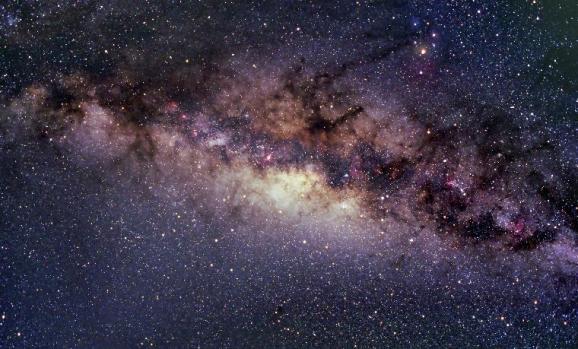Interactive Milky Way Map [Video]

Over the last decade, the Spitzer Space Telescope has taken more than two million photos of the Milky Way. Now, for the first time ever, NASA has created an interactive mosaic of those images to provide viewers with the clearest infrared panorama ever of our home galaxy. Robert Hurt, a NASA imaging specialist explains that a print out of the map would effectively be larger than a professional football stadium. Even given the size of the current map, these two million images still only make up a small portion of our night sky, approximately three percent. That three percent, though, shows more than half the stars in the Milky Way because of the way the galaxy is shaped. Now, astronomers, scientists, and the general public may conveniently view the Milky Way, day or night, from their own computers using the newly released interactive map.
The engineers and astronomers at NASA developed methods to provide a 360-degree view of the galaxy. The mosaic was created in conjunction with the Galactic Legacy Mid-Plane Survey Extraordinaire (GLIMPSE360) project. According to NASA, it allows viewers to even see stars which are obstructed by interstellar dust. The Spitzer Space Telescope was launched in 2003 and has spent time not only taking pictures of the galactic plane but has also studied asteroids and attempted to locate the most remote galaxies on the edges of the observable universe. Spitzer spent 4,142 hours, a full 172 days, taking pictures of the Milky Way galaxy in infrared light. The images have been placed together in an interactive, zoomable, 360-degree map of the Milky Way. The total image file size comes in at 20 gigapixels.
Spitzer took the images in the infrared spectrum which allows stars obstructed from view by space dust to be seen. One of the main goals of the project was to get a more complete map of the galaxy including the spiral arms to determine the actual galactic edges. Using data from GLIMPSE, astronomers have been able to create the most accurate map of the center of the galaxy, a large central bar of stars. This information revealed that the Milky Way is slightly larger than researchers had originally believed. Other data obtained from GLIMPSE shows that the galaxy is peppered with bubble structures. The bubbles are actually cavities surrounding massive stars. The bubbles blast both radiation and wind into their surroundings.
The Spitzer Space Telescope has been able to map many faint stars and those in some of the darker outer regions which had previously been unexplored. Members of the Spitzer team had already released an image mosaic which catalogued 130 degrees of the galaxy, mostly focusing on the hub. The newly released 360-degree view will allow NASA to focus on some of the most interesting areas with the James Webb Space Telescope. The James Webb Space Telescope will make infrared observations of those particular areas in even more detail for researchers to review.
Looking at the mosaic it is possible to see areas of star formation and distant galaxies. The interactive map also allows viewers to skip to those areas of personal interest using navigation shortcuts. The shortcuts also bring users to some of the most popular destinations. Some of those popular destinations include Canis Major, the massive black hole at the galactic center, and the Cat’s Paw Nebula. The GLIMPSE project is not just for show, however. It is also part of a citizen science project and users can assist in cataloging objects in the Milky Way such as the previously mentioned bubbles. The interactive map of the Milky Way is, to date, the largest, most comprehensive visual map of the galaxy and it is available not just to scientists, but to the public as well.
By Dee Mueller







0 comments:
Post a Comment